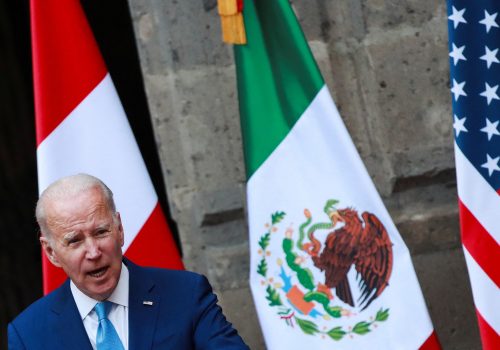With elections in Mexico and the US, 2024 is a pivotal year for North American trade
January 1 of this year marked the thirtieth anniversary of North America’s most ambitious integration project, the North American Free Trade Agreement (NAFTA). This trade deal was renegotiated into the United States-Mexico-Canada Agreement (USMCA), which entered into force in July 2020. For Mexico, the past three decades of North American trade have been transformative, and Mexico is now the United States’ largest trade partner. In Mexico, there is no doubt about the importance of maintaining the commercial relationship with the United States and Canada to boost economic growth and create well-paid jobs.
At the same time, 2024 will be pivotal in determining the agreement’s future. The governments elected in Mexico on June 2 and in the United States on November 5 will be responsible for conducting an important review of the USMCA scheduled for July 2026. The priority both countries’ leaders give to the agreement and the vision they adopt on integration will determine Mexico’s commercial relationship with its partners in the region going forward. The best way for Mexico to protect its economy and its North American trade relationships is by ensuring compliance with its USMCA commitments before 2026, reducing the pressures that it might be subject to from the other parties in the review.
How does the USMCA review process work?
Unlike NAFTA, the USMCA considered the possibility of the agreement coming to an end. Indeed, in Article 34.7 (Review and Extension of Validity), the agreement establishes a validity period of sixteen years (until June 30, 2036), but also a review clause in the sixth year (July 1, 2026). This sixteen-year period can be modified if the three countries confirm, in the sixth year, their intention to extend the USMCA for another sixteen years (until 2042).
However, the USMCA also considers the possibility that the parties do not agree to extend the life of the agreement in the sixth year. If they don’t, this leads to a periodic review of the treaty between the sixth and sixteenth year. During these ten years, the three countries can agree, at any time, to extend it an additional sixteen years.
These conditions were imposed by the United States during the renegotiation of NAFTA, reflecting the Trump administration’s unilateral and often protectionist vision for North American integration. The conditions also speak to the United States’ interest in ensuring that its partners offer greater concessions in each review.
What to expect from the review
First, the review of the USMCA is uncharted territory and can generate great uncertainty. There is no other trade agreement in which Mexico, the United States, or Canada face such conditions for extension. Uncertainty about the agreement’s permanence goes against the purpose of creating a legal framework that offers security to businesses. The mere possibility of the agreement having its validity cut short can raise doubts for companies about their investment decisions, particularly in Mexico, as it cannot guarantee long-term preferential access to the markets of the United States and Canada.
The trade war between the United States and China and US “nearshoring” efforts have allowed the issue of the agreement’s survival to appear secondary. However, this issue can’t just be swept under the rug. To mitigate this situation, Mexico must work hard to create an economic environment that provides greater certainty than what the USMCA offers and encourage investments even in a context where the agreement does not guarantee its long-term existence.
Second, 2024 will set up what could happen in 2026. The USMCA establishes that in the sixth year since its entry into force, the Free Trade Commission will meet to review its operation and consider any recommendation presented by a party “at least one month before the joint review meeting of the Commission takes place.” The governments of the United States and Mexico elected in 2024 will be responsible for reviewing the commitments made in 2026. Last December, the chief executive officer of the Canadian Chamber of Commerce, Perrin Beatty, urged Canadian Prime Minister Justin Trudeau to start work on this first review in 2024. For Mexico, the inauguration of a new government in 2024 represents an opportunity to carefully analyze its USMCA implementation, make necessary adjustments, and demonstrate its commitment and interest in being part of this agreement.
Any US administration is likely to seek to ensure that its partners meet their commitments. However, in the case of a Democratic administration, expect that the United States will continue to prioritize labor issues under the Rapid Response Labor Mechanism, a dispute settlement provision in the USMCA. For Mexico, the review could lead its partners to point out a long list of noncompliance and pending issues, such as “telecommunications, biotechnology, medical devices, food labeling, energy, customs and trade facilitation, and electronic payment services, among others.” Mexico will also have the opportunity to request that the United States comply with the determination of the USMCA rules of origin panel, which it has so far ignored. Therefore, when the new Mexican government takes office this October, it is vital that it quickly undertakes a comprehensive review of compliance with the USMCA and, above all, work to ensure that the three partners agree to extend the validity of the agreement for sixteen more years.
Third, it is important to establish that a review is not a renegotiation. Recently, some trade experts have talked about the 2026 review as a potential renegotiation of the agreement, which is unnecessary and undesirable. The USMCA is a broad and deep agreement that has barely been in force for three-and-a-half years. According to the USMCA text, reviewing means verifying the operation of the agreement. The treaty does not mention the possibility of renegotiating, which would entail a more complex process, requiring authorization from the US Congress and notification to the Canadian Parliament. A renegotiation would likely require concessions in all areas covered by the USMCA to ensure access to the markets of all three partners. It is crucial that the agreement’s provisions mature before its substance is changed once again. The review should result in a stronger agreement and ensure that the three countries fully meet their commitments.
This will be a year of intense political debates. Migration and drug trafficking will be two key challenges in the Mexico-United States relationship. Although trade has taken a backseat to these issues, Mexico is an important partner in “nearshoring” and strengthening manufacturing in the United States and North America as a whole. As of October 1, 2024, the new Mexican government will have the responsibility and the opportunity to demonstrate its true commitment to the USMCA and to North American trade. Mexico must position itself as a reliable and committed partner in regional integration and try to ensure a smooth 2026 review process. This could be achieved with Mexico advancing public policies and taking actions consistent with the commitments agreed to in the treaty.
Luz María de la Mora is a nonresident senior fellow with the Atlantic Council’s Adrienne Arsht Latin America Center, where she supports the Center’s Mexico work. From December 2018 to October 2022, she served as undersecretary of foreign trade in the Mexican Secretariat of Economy, during which she helped implement the USMCA.
Further reading
Fri, Jan 12, 2024
2024 predictions: How ten issues could shape the year in Latin America and the Caribbean
Spotlight By
How will the region ride a new wave of changing economic and political dynamics? Will the region sizzle or fizzle? Join in and be a part of our ten-question poll on the future of LAC.
Mon, Feb 27, 2023
Ten minutes at the border: Revving the US and Mexican economies
Report By
Atlantic Council research shows that a mere 10-minute reduction in wait times at the US-Mexico border can have increasingly positive effects on communities and economies on both sides of the border.
Tue, Feb 28, 2023
Mayors and governors will drive the future of North American economic integration
New Atlanticist By Willow Fortunoff, Mary Ann Walker
Local leaders are forging ahead on initiatives that enhance North American economic collaboration. By excluding them from key international summits, national leaders are missing out on a big opportunity.
Image: A voter casts his ballot at a polling station during the presidential election in Mexico City, Mexico, July 1, 2018. REUTERS/Carlos Jasso


